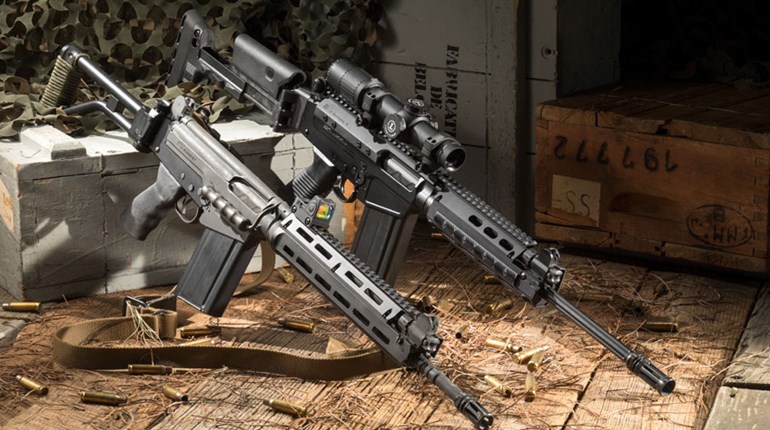
Considering the political climate these days, a lot of people are buying semi-automatic rifles in fear of looming restrictions. Although there are many choices out there, for those looking for a full-size 7.62x51 mm gun, the FAL-pattern rifle can make an excellent choice. Adopted by nearly 100 countries and manufactured in massive numbers, the FAL represents a proven and established design.
The FAL has many positive attributes, including impressive power, good reliability, plentiful spare parts, etc. It also has one other unique attribute—a highly adjustable gas system that allows users to tune the rifle to a particular loading.
Devil's in the Details
On its surface, the metric-pattern FAL's adjustable gas system seems reasonably simple and straightforward. Located in the gas block in the forward portion of the handguard and integral to the front sight assembly, the gas system features a large gas plug on its forward face that retains the FAL's gas-piston assembly. The rotating gas plug has two settings—"A" for open and "Gr" for closed. The "A" setting is the normal setting that allows gas through to cycle the action. The "Gr" setting cuts the gas system off completely for when the rifle would be used to fire grenades.
But a closer look reveals more. To the rear of the gas block is a regulator sleeve that wraps around the rifle's gas tube. This regulator controls the amount of gas bled from the bore used to drive back the piston and cycle the action. Rather than simply two or three settings as is common with other systems, this regulator features 14 adjustment settings with seven numbered markings. It is important to note that some standard-pattern (as opposed to metric) L1A1-style rifles do not have numbered markings on their regulators.
These finely tuned points of adjustment on the regulator sleeve allow users to tune the system. Shooters can allow just enough gas through to the piston to cycle the action while minimizing fouling and unnecessary wear and tear on the rifle.
My Turn
So, how does a new FAL owner get his rifle set up for his preferred loading? I actually had an opportunity to learn this for myself recently, as I decided to add an FAL to my collection. The rifle I selected was a DS Arms STG58 (www.dsarms.com), one of the best deals on the market right now in my opinion. It combines original new-condition Austrian parts with new U.S.-made parts for an FAL retailing just under $1,200.
Included with every FAL rifle from DS Arms is an FN FAL owner's manual with concise directions on the operation and maintenance of the rifle. A quick flip through it brought me to a section on adjusting the gas setting of the rifle, and it had me up to speed in no time. I then headed out to the range with the rifle, the manual and a few boxes of Black Hills Match 168-grain boat-tail hollow-point ammunition.
Following the instructions, tuning the FAL's gas system proved to be quite simple. Adjustments to the regulator sleeve can be made with either a special wrench or by using the tip of a bullet inserted into the numbered holes on the sleeve.
Step by Step
The user should begin with the rifle empty and clear. Adjust the regulator so it is fully closed against the gas block and the "1" setting is visible on the top portion. This setting allows the maximum amount of gas through to impact the piston. Conversely, the "7" vents the most gas away, allowing only a small amount through to impact the piston.
Operation 1: Unscrew the regulator sleeve from the gas block until it is in the fully open position with "7" visible on top. After inserting an empty magazine into the rifle, single load a cartridge through the ejection port and then fire the rifle. This should result in a short recoil that does not allow the magazine to engage the hold-open device.
Operation 2: Screw the regulator sleeve forward click-by-click, firing one round after each change until the action is locked open by the empty magazine. At this point, you know enough gas is being allowed against the piston to cycle the action.
Operation 3: Fire several more rounds in this method to verify it will reliably cycle the action fully.
Operation 4: If any shot results in a short recoil failing to lock the action open, click the regulator forward one more setting and test again.
Operation 5: Repeat operations 3 and 4 as needed until the rifle cycles reliably.
Operation 6: The correct gas setting should now be determined. However, it is a good idea to click the regulator forward two more settings. For example, if you found that setting "4" cycled the rifle, click two more positions down. Counting the half-position setting between "4" and "3," this would put you on the "3" setting.
Just Right
With just a little bit of effort, thanks to its highly adjustable gas system, an FAL owner can tune the rifle to a particular loading. This allows you to regulate the system so enough gas gets through to cycle the action, but not so much that you cause premature wear and tear on your rifle. This is just the sort of firearm regulation we can live with!




































